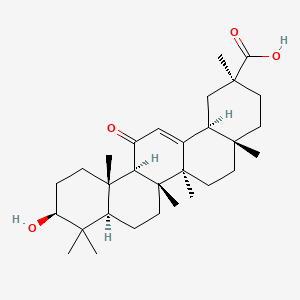| Authors | Title | Published | Journal | PubMed Link |
|---|---|---|---|---|
| Kalaiarasi P et al. | Hypolipidemic activity of 18beta-glycyrrhetinic acid on streptozotocin-induced diabetic rats. | 2009 | Eur. J. Pharmacol. | pmid:19361497 |
| Li WC et al. | Locomotor rhythm maintenance: electrical coupling among premotor excitatory interneurons in the brainstem and spinal cord of young Xenopus tadpoles. | 2009 | J. Physiol. (Lond.) | pmid:19221124 |
| He B et al. | Tramadol and flurbiprofen depress the cytotoxicity of cisplatin via their effects on gap junctions. | 2009 | Clin. Cancer Res. | pmid:19723651 |
| Sato T et al. | Effect of gap junction blocker beta-glycyrrhetinic acid on taste disk cells in frog. | 2009 | Cell. Mol. Neurobiol. | pmid:19145483 |
| Trepel M et al. | A heterotypic bystander effect for tumor cell killing after adeno-associated virus/phage-mediated, vascular-targeted suicide gene transfer. | 2009 | Mol. Cancer Ther. | pmid:19671758 |
| Kaneda M et al. | Direct formation of proteo-liposomes by in vitro synthesis and cellular cytosolic delivery with connexin-expressing liposomes. | 2009 | Biomaterials | pmid:19423159 |
| Classen-Houben D et al. | Selective inhibition of 11beta-hydroxysteroid dehydrogenase 1 by 18alpha-glycyrrhetinic acid but not 18beta-glycyrrhetinic acid. | 2009 | J. Steroid Biochem. Mol. Biol. | pmid:19429429 |
| Iqbal Choudhary M et al. | Microbial transformation of 18beta-glycyrrhetinic acid by Cunninghamella elegans and Fusarium lini, and lipoxygenase inhibitory activity of transformed products. | 2009 | Nat. Prod. Res. | pmid:19384727 |
| Kalaiarasi P and Pugalendi KV | Antihyperglycemic effect of 18 beta-glycyrrhetinic acid, aglycone of glycyrrhizin, on streptozotocin-diabetic rats. | 2009 | Eur. J. Pharmacol. | pmid:19374864 |
| Kim DE et al. | Glycyrrhizin prevents 7-ketocholesterol toxicity against differentiated PC12 cells by suppressing mitochondrial membrane permeability change. | 2009 | Neurochem. Res. | pmid:19224363 |
18alpha-glycyrrhetinic acid
18alpha-glycyrrhetinic acid is a lipid of Prenol Lipids (PR) class. 18alpha-glycyrrhetinic acid is associated with abnormalities such as Wiskott-Aldrich Syndrome. The involved functions are known as inhibitors, salivary gland development and branching morphogenesis.
Cross Reference
Introduction
To understand associated biological information of 18alpha-glycyrrhetinic acid, we collected biological information of abnormalities, associated pathways, cellular/molecular locations, biological functions, related genes/proteins, lipids and common seen animal/experimental models with organized paragraphs from literatures.
What diseases are associated with 18alpha-glycyrrhetinic acid?
18alpha-glycyrrhetinic acid is suspected in and other diseases in descending order of the highest number of associated sentences.
Related references are mostly published in these journals:
| Disease | Cross reference | Weighted score | Related literature |
|---|
No disease MeSH terms mapped to the current reference collection.
PubChem Associated disorders and diseases
What pathways are associated with 18alpha-glycyrrhetinic acid
There are no associated biomedical information in the current reference collection.
PubChem Biomolecular Interactions and Pathways
Link to PubChem Biomolecular Interactions and PathwaysWhat cellular locations are associated with 18alpha-glycyrrhetinic acid?
There are no associated biomedical information in the current reference collection.
What functions are associated with 18alpha-glycyrrhetinic acid?
Related references are published most in these journals:
| Function | Cross reference | Weighted score | Related literatures |
|---|
What lipids are associated with 18alpha-glycyrrhetinic acid?
There are no associated biomedical information in the current reference collection.
What genes are associated with 18alpha-glycyrrhetinic acid?
There are no associated biomedical information in the current reference collection.
What common seen animal models are associated with 18alpha-glycyrrhetinic acid?
There are no associated biomedical information in the current reference collection.
